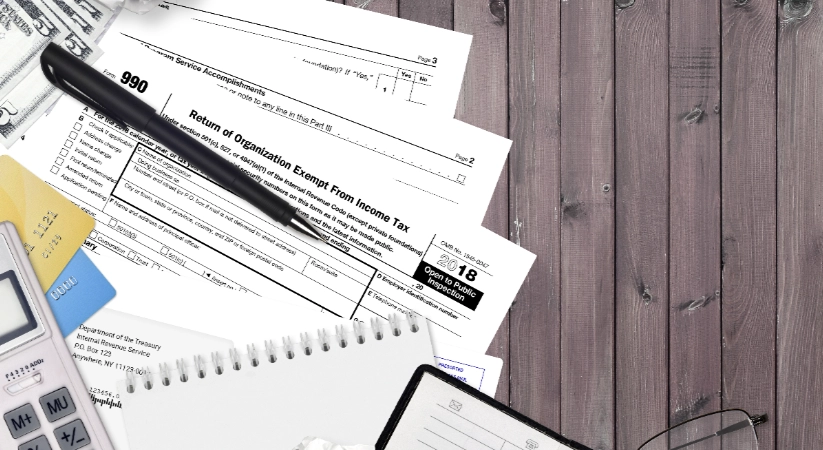Which 990 Form Should My Tax-Exempt Organization Use?
Published:
You might be exempt from taxes, but no one’s exempt from paperwork!
What is IRS Form 990 and why is it important?
IRS Form 990 is a critical document for nonprofit organizations to maintain their tax-exempt status. This information return provides financial and operational data to the Internal Revenue Service (IRS), the federal agency responsible for overseeing tax-exempt organizations.
There are several versions of Form 990 available, depending on the size and revenue of the organization. The most widely used forms are 990, 990-EZ, and 990-N, also known as the e-Postcard. The filing thresholds for each version vary, with 990 and 990-EZ typically required for organizations with higher revenue and 990-N for smaller organizations. Form 990 itself is required for most organizations exempt from income tax, as well as political organizations and nonexempt charitable trusts.
It is important to accurately complete Form 990 to maintain tax-exempt status and avoid penalty assessments. The penalties for incorrect or late filing can be significant, with the maximum penalty currently set at $61,820 for larger organizations. Additionally, incorrect filing can result in the loss of tax-exempt status altogether.
Nonprofit organizations must include a range of financial and operational information on their Form 990, including income and expenses, program service accomplishments, fundraising expenses, and details on the organization’s primary officer. Accurate completion of these sections is essential to meeting the annual reporting requirement and demonstrating compliance with federal regulations.
Accurate completion is essential to avoid penalty assessments and demonstrate compliance with federal regulations.
What is Form 990-N?
Form 990-N, also known as the e-Postcard, is a version of the annual information return that smaller tax-exempt organizations must file with the IRS. This form is designed for organizations with gross receipts of less than $50,000 per year, and it includes a few basic questions designed to confirm the organization’s continued eligibility for tax-exempt status.
Who qualifies to use Form 990-N?
Form 990-N, also known as the e-Postcard, is a shorter version of Form 990 that some tax-exempt organizations may qualify to file. To qualify for using Form 990-N, an organization must meet certain criteria. Small tax-exempt organizations with annual gross receipts of $50,000 or less usually are eligible to file Form 990-N. The determination of gross receipts is based on the average of the organization’s annual revenues for the three most recently completed taxable years.
Additionally, the age of the organization also plays a role in determining if it can use Form 990-N. Organizations that have been in existence for less than four years can also qualify to file Form 990-N, as long as their gross receipts in each of their first two tax years were $75,000 or less.
It is important to note that some organizations may still qualify for tax-exempt status even if they do not meet the criteria for filing Form 990-N, and would need to file the longer Forms 990 or 990-EZ. However, for small tax-exempt organizations that meet the criteria, filing Form 990-N satisfies their annual reporting requirement.
Can I file Form 990-N electronically? How do I file Form 990-N?
If you’re wondering if you can file Form 990-N electronically, the answer is yes! In fact, electronic filing is the only option for this form. Paper forms are not accepted, so you must submit the form electronically using an IRS authorized e-file provider.
To file Form 990-N electronically, you’ll need to provide basic information about your organization, such as the name, address, and EIN. Additionally, you’ll need to share program details, including a brief description of your exempt purpose and any significant accomplishments from the past fiscal year.
Once you have provided all the necessary information, be sure to verify that everything is correct before submitting the form. It’s important to double-check every detail before submitting to avoid any errors or penalties. Once you have verified everything, you can hit “submit” and your Form 990-N will be sent to the IRS.
Electronic filing is the only option for 990-N, and the deadline is the 15th day of the 5th month after the end of the organization’s accounting period (or the next business day if it falls on a holiday or weekend.) For example, if an organization follows the calendar year, their deadline would be May 15th. (If a due date falls on a holiday or weekend,
It’s crucial to plan and ensure that your non-profit organization has enough time to file it within the deadline correctly. Missing the deadline could result in incorrect filing, late filing, or even penalty assessment, all of which could put your organization’s tax-exempt status in jeopardy.
What is Form 990-EZ?
Form 990-EZ, Short Form Return of Organization Exempt from Income Tax, is an annual information return that nonprofit organizations use to provide the IRS with a snapshot of their financial activities for the year. This form is a condensed version of the longer Form 990, making it an attractive option for organizations who meet specific criteria based on their annual gross receipts and total assets. In this article, we will explore the details of Form 990-EZ, its filing requirements, and its significance to tax-exempt organizations.
Who qualifies to use Form 990-EZ?
Form 990-EZ is an annual financial reporting form designed for tax-exempt organizations by the Internal Revenue Service (IRS). The Form 990-EZ is perfect for small to medium-sized organizations that fall between the smallest and largest annual reporting requirements: less than $200,000 in gross revenue and assets that are less than $500,000.
The organizations that typically qualify for this form include 501(c)(1) to 501(c)(29) organizations. Examples of such organizations are social clubs, agricultural organizations, and labor organizations.
Filing Form 990-EZ is an ideal annual reporting requirement option for many small to medium-sized organizations. It is a more straightforward and less detailed reporting requirement than larger Form 990 filings, yet it requires more information than the smaller 990-N e-postcard filing.
By carefully considering the qualifying criteria, gross revenue, assets, and eligible organizations for Form 990-EZ, organizations can determine whether this form is the best filing option for their needs.
What’s the right way to send Form 990-EZ?
As a tax-exempt nonprofit organization, filing Form 990-EZ is an essential task that needs to be done in a timely and accurate manner to maintain your organization’s tax-exempt status. Organizations sponsoring a donor advised fund are required to file Form 990 instead of Form 990-EZ. In addition, organizations defined as controlling entities in section 512(b)(13) must also use Form 990 if there was any transfer of funds between them and a controlled entity during their tax year.
Please verify the accuracy of your EIN, Tax Period, and GEN (if applicable) and ensure that your organization’s tax-exempt status is correctly indicated by referencing the appropriate Internal Revenue Code subsection as stated in your determination letter. To complete Form 990-EZ, a proper signature is required in the signature block (Part VI). An officer of the organization must sign the return. If it is a corporation or association, the president, vice president, treasurer, assistant treasurer, chief accounting officer, or tax officer may sign. If it is a trust, the authorized trustee(s) must sign.
All 501(c)(3) organizations and section 4947(a)(1) nonexempt charitable trusts must complete all of Part VI of Form 990-EZ.
Carefully read the instructions for each of the required schedules. Complete all applicable parts and lines. Answer each question, unless otherwise instructed for a particular question. Make an entry on all total lines including zero when appropriate.
What is the deadline for my 990-EZ?
The deadline for filing the IRS Form 990-EZ is on the 15th day of the fifth month after the end of your organization’s fiscal year. For instance, if your fiscal year ended on December 31st, then your form is due on May 15th. Noncompliance with the deadline may result in potential penalties of $20 per day, with a maximum of $10,000 or 5% of your organization’s gross receipts (whichever is less). On top of that, failing to file for three consecutive years may lead to losing the tax-exempt status of your organization.
It’s essential to comply with the filing deadline to avoid any penalties and maintain the organization’s tax-exempt status. In case your organization needs an extension to file the Form 990-EZ, you can apply for a six-month extension by filing Form 8688 before the original deadline. This way, your organization won’t suffer any penalty from the IRS but must ensure to comply with the extended deadline for filing the form.
As an organization, it’s crucial to understand and comply with the filing deadline for the IRS Form 990-EZ to avoid any penalty assessment or loss of the tax-exempt status.
What are the differences between IRS Form 990-N and IRS Form 990-EZ?
As a tax-exempt organization, it’s important to comply with the required annual reporting requirements to maintain your organization’s tax-exempt status. Two forms that organizations may use for their annual reporting are Form 990-N and Form 990-EZ. While both forms serve the same purpose, there are significant differences between them. Organizations with a lower gross receipts threshold can use the simpler Form 990-N while those with slightly higher receipts can use Form 990-EZ for more detailed financial reporting.
Form 990-N, also known as the e-Postcard, is the simplest version of the form. It is used by eligible tax-exempt organizations whose annual gross receipts are normally $50,000 or less. With Form 990-N, organizations simply report their basic information, such as their legal name, address, and EIN, along with a statement that their gross receipts are less than the $50,000 threshold.
Form 990-EZ, on the other hand, is a longer form that requires additional financial information. Organizations whose annual gross receipts are less than $200,000 and whose total assets are less than $500,000 can use this form. With Form 990-EZ, organizations must report their gross revenue from program services and investment income. They must also provide detailed information on their program service accomplishments and revenue, along with additional financial and governance information.
Filing Due Date
Filing due dates are crucial for nonprofits and tax-exempt organizations as they must file the appropriate forms with the Internal Revenue Service (IRS) in a timely manner to avoid any penalty assessment. For organizations that need to file Form 990, the due date is the 15th day of the 5th month after the tax period ends.
It is important to note that for organizations whose tax year ends other than December 31, the due dates for Form 990 may differ. Therefore, it is recommended to check the Form 990 deadlines provided by the IRS to ensure compliance.
On the other hand, Form 990-N also known as the e-Postcard, has a different filing due date. This form is used by eligible tax-exempt organizations whose annual gross receipts are normally $50,000 or less. It’s due every year by the 15th day of the 5th month after the close of the organization’s tax year.
It should be noted that if the due date falls on a weekend or a legal holiday, the due date for both Form 990 and Form 990-N falls on the next business day.
In conclusion, staying on top of filing due dates is essential for maintaining tax-exempt status and avoiding any penalty assessment. Nonprofits and tax-exempt organizations should ensure that they are filing the appropriate forms on time and checking for any deadlines provided by the IRS.
Problems Filing Form 990 and How to Address Them
An organization eligible to file Form 990 may face a number of issues during the filing process, including website or filing system issues, incorrect filing, and late filing. Here are some tips on what to do if these issues arise:
Website or Filing System Issues:
In some cases, organizations may encounter problems with the IRS website or filing system. These issues may arise due to technical difficulties, unexpected errors, or system maintenance. If you encounter any issues with the IRS website or filing system, it is recommended that you refer to the How to File: Frequently Asked Questions (FAQs) section for assistance. This section contains helpful information on how to troubleshoot common issues and navigate the filing process.
Incorrect Filing:
Another issue that organizations may face when filing Form 990 is incorrect filing. This can happen when the wrong form is filed, or when the information on the form is incomplete or inaccurate. If you realize that you have made an incorrect filing, it is important that you take immediate action to correct the mistake. You can do this by filing an amended return using the appropriate form.
Late Filing:
Late filing is a common issue that organizations face when filing Form 990. If you miss the filing deadline, you may be subject to penalties and fees. To avoid these penalties, it is important to file your return by the deadline. If you are unable to file your return on time, you can request an extension by using Form 8868. This form will give you an additional six months to file your return.
Who doesn’t need to use Form 990?
In general, organizations with gross receipts of less than $50,000 are not required to file Form 990 with the IRS. This means that small organizations such as neighborhood associations, community sports teams, and small support groups are exempt from filing.
Certain religious organizations are also exempt from filing, including churches, integrated auxiliaries, conventions or associations of churches, and religious orders that meet specific IRS requirements. These organizations are not required to file Form 990 or any variant of it.
Organizations that are considered part of a group return may also be exempt from filing. A group return is when a central organization files Form 990 on behalf of its affiliated subordinate organizations. In this case, the individual subordinate organizations are not required to file their own separate Form 990.
Private foundations, on the other hand, must always file Form 990 or Form 990-PF, regardless of their gross receipts. Private foundations file Form 990-PF, which is a variation of Form 990 that is designed specifically for private foundations. These organizations are required to file annually, and failure to do so may result in penalty assessment and loss of tax-exempt status.
Not all tax-exempt organizations are required to file Form 990 with the IRS.
Small organizations, religious organizations, organizations that file as part of a group return, and private foundations are some of the organizations that may be exempt from filing. Organizations that are unsure of their annual reporting requirement should consult with a tax professional to ensure compliance with legal and regulatory requirements.



